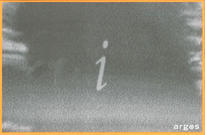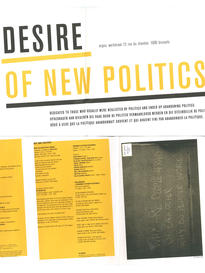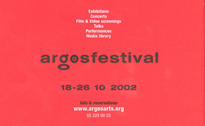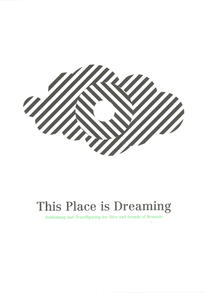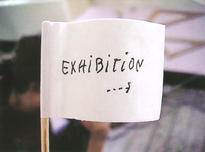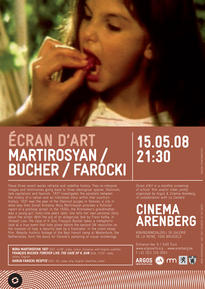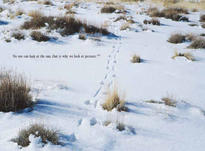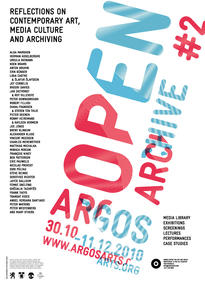HISTORY
The website and mission of ARGOS are currently being revised. Stay tuned for updates in the coming year!
Argos was founded in 1989 for the purpose of stimulating and promoting audiovisual art; at present it is the country’s main source of reference for this type of artistic practice.
1989 -
1994
During the first period the organisation focuses on showing a wide variety of works within Belgium. In 1990 Argos sets-up festivals in Antwerp, Brussels and Louvain related to the films and videos realised by Jean-Luc Godard in the 1980s. This is followed in 1991 by 'Dancing Images', a festival taking place in those same cities, centring on the relationship between film/video and dance. From 1992 onwards Argos holds a range of thematic programmes in the majority of Belgian arts centres. Apart from organising screenings, Argos also operates as a distributor. Works are thereby distributed to (mainly) foreign festivals, cultural centres, museums and television networks.
1994 -
1996
As hitherto there was no such thing as state funding for the mediating --typically non-commercial tasks, Argos dealt with these itself, soon accruing a deficit. In 1994 the Flemish Community allocates an operational subsidy for the first time, allowing Argos to make a start in decreasing its debts.
1996 - 1999
The realisation of a centre takes shape in 1996,
when Argos finds accommodation in the gallery complex at Kanal 20, a Brussels
premises situated on the canal, and starts exhibiting video and multimedia
installations in its very own space. 'Eclipse' by Antwerp artist Anne-Mie van
Kerckhoven, is the first presentation, to be followed by projects from Koen
Theys, Richard Venlet, Garry Hill, Pascal Baes, Georges Bures Miller, Frank
Theys, David Claerbout, and others.
In 1997 the first 'Argos Information
Days' are held, with great success, offering an annual preview of Belgian
artists' films and videos. The event continues until 2001, when it is
incorporated as the Belgian Focus section within the 'Argosfestival' that starts
the same year.
Argos moves to the first floor of a former warehouse off Sainctelette Square in
1999. With a floor area of
500 square metres, of which 300 are solely allocated as exhibition space, Argos
is able to operate on a challenging, international and logistically appropriate
scale. The space is primarily used for solo exhibitions; in general, projects
that are coproduced by Argos. Artists exposing during this beginning period
are, amongst others: Jan De Cock, Jayce Salloum, Heinz Emigholz en Joëlle
Tuerlinckx.
Architects Kris Kimpe and Bruno Poelaert design a public media library
and the Black Box, a separate project space in which video projections and
lectures can take place. At the same time a climate controlled archive room is
provided. In 2002 French artist
Mathieu Mercier realises an integrated art project for the glass door sections
of the media library. In the same year, in a separate building situated across
from the offices, Argos sets up a workshop where artists can find support
facilities.
2000
The video conservation programme starts up. The first project includes more than 100 titles containing an important body of Belgian works from the 1970s. It is the beginning of a conservation effort that, to date, contains more than 2.000 titles. Argos also begins to make its own publications, an activity that over the years results in some twenty catalogues and a number of limited and audiovisual editions.
2001-2002
The first floor space at Argos is renovated.
2001-2005
For five full years the 'Argosfestival' offers a platform for various forms of artistic expression within the domain of the audiovisual media. With, on average, ten locations, the festival spans the city. A whole spectrum of activities takes place: exhibitions, film and video presentations, concerts, interventions in the public space, lectures and symposiums. At the end of 2005 it is decided to stop the festival and to spread the programme over the entire year, rather than over ten days. For this reason, an expansion of the premises is planned, along with other improvements. During the same year, Argos engages in the ‘écran d'art’ (art screen) series, the monthly screening of artists’ film and/or video, jointly organised by Argos and Cinema Arenberg. Also in 2005, Cera becomes a patron of Argos and allocates a subsidy for the subsequent three years, with which to extend the library, and, more particularly, to realise an online presentation of the collection.
2006
On the first of January Argos enters into The Arts decree, new subsidy
legislation that supports the emancipation of all art disciplines and provides
funding covering several years. Argos is recognised as an arts centre. With
this comes an end, at the Flemish Community level, of more than ten years of
one-year or project subsidies within all kinds of smaller subsidy regulations.
At the end of 2006 Argos undertakes
a huge rebuilding programme. The ground floor is expanded to achieve an extra
500m², increasing the overall area of exhibition space to over 800m². It is
reinstated as a reception and major exhibition/presentation area.
The new ground floor, which is complementary to the existing exhibition space on the first floor, can accommodate large group or solo exhibitions, as well as talks, performances, screenings and musical events.
2007-2008
The expanded public spaces are abundantly filled. Diverse group exhibitions are presented, as well as individual projects. On Thursday evenings there are lectures, concerts and other presentations in the foyer. At the end of 2007 Open Archive takes place, a large-scale event-focused programme that uses the Argos archive as a motive for numerous presentations, lectures, symposiums or performances. The four-day event, FRONT-end, happening in September 2008, marks the launch of the online media library catalogue.
2009 - 2010
In the course of 2009, several thematic and solo exhibitions take place at Argos, while extra muros an active collaboration is set up with international partners as well as with partners in the city, among others, the nearby Kaaitheater and the KunstenFestivaldesArts. In the fall of 2009, Argos invites five artists and collectives from very different backgrounds to reflect about their position as an artist in nowadays society. After a year long working process that functions as an open platform, the participating artists and collectives present a series of public programs called 'Salon5': an unusual combination of trips out of Brussels with screenings, picnics, guided visits, performances, walks and lectures.
While Argos's collection keeps growing steadily, a second edition of 'Open Archive takes place at the end of 2010. Once again, discursive trajectories are drawn from the collection, giving way to exhibitions, presentations and lectures, symposiums and performances. To this end, the ground floor is permanently transformed into a pleasant bar and meeting area where, among other things, Argos's publications can be consulted too.
2011-2013
Dynamizing the collection.
The collection becomes the focus of the organization. Thus certain thematic lines or oeuvres are explored more in depth and developed so that they can be presented as a whole. Through exhibitions and projects within our premises and extra muros, Argos seeks to dynamize its collection and articulate it as a constantly evolving whole. The perspective remains both national and international. In 2011-2013 for example we staged not only the first solo exhibition by Nicolas Provost, as well as the first solo exhibition by Harun Farocki in Belgium, but also Meeting Points 6 (together with YATF), for which Okwui Enwezor was invited as curator. In the latter project we took full advantage of our multidisciplinarity: apart from the exhibition, we also had a fully-fledged performance and a series of lectures. For exhibitions and projects we worked together with various organizations, such as the Kaaitheater (Boris Charmatz), Contour (Flemish Parliament). The film distribution was reorganized and anchored in a more active model.
Argos seeks to become more flexible as an art centre, and also devotes itself to its role as a collection-managing heritage institute.
In the autumn of 2011, Argos recruits a collection manager and we move from a dual directorship to a general director.
In 2011 we work together for the first time with Heritage Day; at the same time, in January 2011 the European Commission and the DCA Consortium—together with 25 partner institutions of 10 European partners and the two allied countries Croatia and Iceland—officially start the Digitising Contemporary Art (DCA) project. Argos is content provider for the DCA project, which is intended to improve the online visibility of contemporary art, because art is an essential expression and an invaluable building block of European culture. The project also seeks to raise public interest through a stronger presence of contemporary art in the Europeana portal, which provides unique access to Europe’s cultural heritage. The DCA project lasts till July 2013 and contributes to a reflection about and the development of new strategies for the long-term preservation of the contemporary artistic heritage. Argos completes its collection in function of the DCA project, while the digitized audiovisual information becomes available online. Afterwards Argos builds a radically new website, which now becomes a discursive online platform.
2014-2018
Thematizing.
More than ever Argos focuses on cooperating with other cultural institutes and players in the field, both in its home town and elsewhere. Thus on various occasions Argos works together with the Beursschouwburg for example for a focus programme about politics and the media. In this context Argos presents an exhibition by Erik Bünger and performances, lectures and concerts in the Beursschouwburg.
With deBuren, Argos organizes a series of lectures with audiovisual artists that are linked to the collection and the distribution activities. The screening and lecture series Dissent! (a joint project with Auguste Orts, Courtisane and KASK/HoGent) continues to be successful; some months several events are planned. Also with SoundImageCulture (SIC) Argos strengthens its ties. SIC is an art studio where a collective of visual artists, film makers and anthropologists use their experience to coach professional audiovisual artists and scientists in the creation of their audiovisual projects. Apart from several sessions that take place at Argos in the course of the year, we also provide to opportunity to introduce the works that were created within SIC in Argos’ production, collection and distribution programme.
In addition, since 2013 SIC has had its official headquarters within Argos’ premises. The structural collaboration with SIC aims to increasingly integrate the activities of both organizations in the years to come.
While a range of projects are developed with the Kaaitheater, KunstenfestivaldesArts and Bozar Cinema (for example a Tim Etchells exhibition that departs from the Argos collection, the production of a new work by Etchells, lectures and premieres with Joachim Olender, Ernie Gehr, and others), extra muros events take place in the Concertgebouw Brugge, the Tate Modern London, the Mudam Luxemburg, the School of the Art Institute of Chicago, and at numerous other internationally renowned places.
In 2014 and 2015, Argos increasingly accentuates its own collection with thematic presentations. The collection even becomes the mainspring for the public programme. In order to be able to manage and work on the collection even better, Argos engages a new staff member in February 2015 to strengthen the collection programme. Within the walls of Argos, we present (collection) exhibitions about for example the diversity within Brussels and Belgium or other geopolitical themes; at other venues in Belgium we team up with organizations such as Bildnis/Cinema Rio De Haan, the Lieven Gevaert Research Centre for Photography/Université Catholique de Louvain and the Ghent Cinema OFFoff for thematic programmes with art films from the rich Argos collection.
The choice to interrelate the collection activities with all of Argos’ activities also lays the foundation for a structured and systematic (material-technical and art historical) collection research in the years to come, while the reforms of the public programme and the activity structure will enable us to address a larger and more diverse public with whom we will engage both interactively and on a permanent basis.
